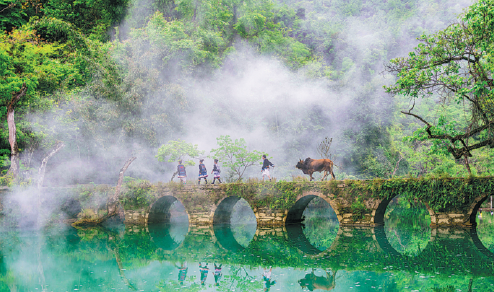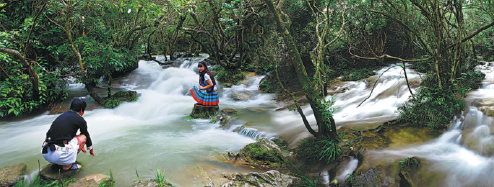A modern wonderland casts its spell
Nature reserve in Guizhou continues to preserve its unique karst landscape and biodiversity, Yang Yang and Yang Jun report.

Over tens of thousands of years, rainwater and heat have combined in the subtropical weather in the south of today's Guizhou province, to allow fauna and flora to survive on rocky soil. But unlike many forests, much of the soil there has washed away because rainwater erodes the rocks of the karst landscape, allowing soil to seep through. Tree roots have to work hard to carry out their function of nurturing growth with such scarce offerings.
The indomitability of life that Zhang Yanquan, a worker with the Maolan National Nature Reserve in Libo county, Qiannan Bouyei and Miao autonomous prefecture, Guizhou, has observed in the forest, has provided him and other people with a new perspective to see the world and themselves.
Several years ago, Zhang showed a couple from Beijing around the forest. He pointed at the thick roots that snaked through the rocks and bared themselves on the surface, telling them that these sturdy trees had battled to survive. About one year later, he received a phone call from them.
"They called to thank me for saving her life," he said on a TV program.
When the couple visited the forest, the wife was seriously ill and depressed but she was inspired by the incredible scenery and eventually pulled through.
"This experience also changed my view of my work. I used to think it was hard work, but now I see the trees that we protect can not only benefit the entire human race, but also can give us some inspiration," Zhang said.
Located in the south of Guizhou, the reserve contains one of the few forests on 25 degrees north latitude on Earth. This is the Libo karst forest, dubbed "the emerald on the belt of the Earth".
The 21,285-hectare reserve shelters more than 2,670 vascular plants, 586 vertebrate animals and 1,589 insect species, including endangered species.
The Libo karst forest, the world's only existing forest of its kind, is part of the South China Karst, a UNESCO World Heritage Site recognized as a representative of karst landform development in the humid tropics and subtropics, with high aesthetic value.
The Libo forest displays the wonders of nature. On a clear day, one can see giant "alien" conical peaks carpeted with thick green trees standing sentinel. A ribbon of leaden cement, a trail for visitors, meanders almost lazily through.
Studying ecosystem
In January, a group of 20 teachers and students from Guizhou University arrived in Libo to choose a sample location to conduct a biodiversity investigation into the karst forest ecosystem, together with five staff members from the reserve.
Yan Lingbin, a teacher from the College of Life Sciences in Guizhou University, says they have followed the international academic standards to choose a square sample location of 25 hectares, including a part of the Libo forest that can best represent its ecosystem.
The diverse creatures that live there have been less disturbed by human activities, so the forest is preserved as a typical, primordial ecosystem of evergreen and deciduous broad-leaved trees.
The sample location includes the domain of a black king cobra, Yan says, that people often see. "That's one of the reasons we went there to choose the sample location in winter. It was not so hot and we wouldn't meet so many insects and snakes," he says.
Indomitable as it is, life is nonetheless fragile, especially in the ecosystem of the karst forest.
Usually in southern China, with rainwater and heat, soil is thick and fertile. However, in a karst landscape, the rocks are shaped by water. There are many small openings and cracks on their surface and over the years, due to the erosion of rainwater, caves form, so when it rains, the soil seeps through, Yan says.
"Little soil can be maintained in this ecosystem, and it is rare to have forests growing in such an environment. That's why it's fragile and unique," he says.
In karst landscapes, soil and water are easily lost. Moreover, the rocks contain a comparatively higher quantity of magnesium and calcium, so unlike many living environments that are usually acidic, the karst forest is alkaline, and creatures need to adapt to it, which also makes it unique, he says.
A karst forest takes much longer to recover, he says. He cites a statistic that proves the point. It takes about 8,000 years to form soil of 1 centimeter in a karst space, in comparison to dozens of years in other more fertile areas.
Although water leaks through the cracks on the rocks, in subtropical weather, with enough water, animals such as frogs can still flourish, providing enough food for snakes and other predators.
In the university investigation that will span years, researchers will install infrared cameras, sound recorders and digital cameras for phenological monitoring to catch the sounds of birds and frogs, as well as to record the growing process of plants. They will also count the number of species and their population.
This investigation is based on the results of decades of hard work to preserve the karst forest.
Ecotourism training
First established in 1986, the nature reserve protects the karst forest from the risk of fire, felling and poaching.
About five to six years ago, there were residents of ethnic groups living in the core area of the reserve.
They have been relocated to better protect this unique forest and also for the purpose of poverty alleviation, says Yu Dengli, head of the management bureau of the reserve. Yu has been working there for 28 years.
There used to be other karst forests, but most of them disappeared mainly due to damage caused by humans, says Chen Zhengren, senior engineer with the management bureau. He started working in the Libo karst forest in 1989 soon after graduating from university.
The forest, 200 kilometers to the southeast of Guiyang, Guizhou's capital, has been preserved due to difficult access, a comparatively small population and the local people's respect for nature, Yu says.
About 97 percent of the residents living in the buffer areas of the reserve are people of the Yao, Bouyei and Sui ethnic groups.
For example, Yao people will look for herbs in the forest to treat fever or traumatic injuries and to assist childbirth, so they use the forest, rely on it and respect it, he says.
Sui people take ancient trees and rare-shaped rocks as their totems, and Bouyei people have many rituals to worship nature, he says.
Preserving the forest is important, but people whose ancestors lived there for hundreds of years also need to improve their lives.
The core area is mostly closed to people, but in the "experimental area", Yu and his colleagues have been helping people develop the local economy.
For example, residents are encouraged to raise chicken and fish in rice fields, and grow herbs, red rice and fruit trees, but not in the forest. The management bureau also organizes training programs to help locals develop ecotourism. People living in the buffer areas of the reserve have all been lifted out of poverty in 2019.
"We are allowed to properly use the environment on the basis of preservation," Yu says.
"To use properly is to better protect nature because people will see they can benefit from environmental protection."
With decades of efforts, the forest coverage rate has risen from 87 percent in late 1980s to more than 88.61 percent today, says Chen, adding that researchers are working hard to nurture more endangered plants, and in the future they want to enlarge their population in the wild.
Zhao Yandi and Wang Jin contributed to the story.



Today's Top News
- A misjudgment of situation in the first place, destabilizing AUKUS deal may bite the dust: China Daily editorial
- Welcome would be welcomed if sincere: China Daily editorial
- Xi and his wife meet Cambodian King, Queen Mother
- Xi meets Russian State Duma chairman
- Parade a tribute to Chinese people's sacrifices in WWII
- SCO will strongly uphold multilateralism































